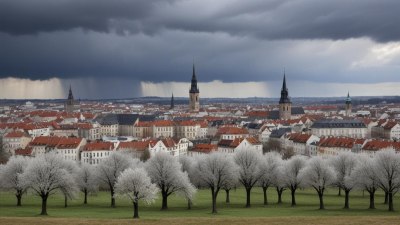Europe’s Weather: A Story of Mild Days, Mood Swings, and Unpredictable Skies
Explore Europe's weather patterns, from mild conditions to unpredictable shifts that affect daily life.

This image was created with the assistance of Freepik
Europe's weather has always been a topic of fascination, generating conversations and debates across the continent. The unpredictable nature of climatic conditions makes Europe a unique place to study weather patterns, particularly as they pertain to the experiences of everyday life. Different regions across the continent showcase a variety of climatic behaviors that evoke a range of elements, from mild sunny days to sudden storms.
To understand the backdrop of Europe's weather, we need to first consider the geographical layout of the continent. Europe's diverse topography includes vast mountain ranges, rolling hills, expansive plains, and idyllic coastal regions. Each geographic feature contributes to its weather patterns, making it a complex arena for atmospheric phenomena. For instance, the Alps and the Pyrenees receive significant snowfall during the winter months, while the coastal areas of the Mediterranean bask in sunlight, creating a contrasting climate.
Historically, weather has shaped European cultures, economies, and lifestyles. Settlements have often been established based on the predictability of food sources and shelter from harsh weather. Traditional harvest festivals, agrarian calendars, and seasonal rituals have all been tailored around expected weather, revealing a deep intertwining of European culture with its meteorological patterns.
The Mildness of European Springs
Spring in Europe can be described as a season of mildness and renewal. Days grow longer, temperatures rise, and flowers bloom in vibrant colors across parks and gardens. The weather during spring can feel temperate, with averages that attract both tourists and locals to step outside and enjoy the beauty of nature. Cities such as Amsterdam, with its tulip-lined canals, and Paris, with its blossoming cherry trees, offer picturesque views perfect for leisurely strolls.
This mild period often encourages outdoor activities such as picnics, festivals, and seasonal markets. In many regions, the warmth of the sun brings laughter and joy as people gather to celebrate the arrival of spring after the dreary chill of winter. However, even in this seemingly serene season, Europe can experience rapid mood swings when it comes to weather. Sudden rain showers, cool breezes, or even hail can surprise residents and tourists alike, showcasing the unpredictable swings of the continent's atmosphere.
Summer Climes and Heat Waves
Summer in Europe can be a mixed bag. In some areas, like Southern Spain and Italy, the weather is characterized by scorching heat and bright sunshine, perfect for beachgoers seeking to relax under the sun. Coastal cities flourish, with bustling tourist crowds, festivals, and endless outdoor activities. The Mediterranean climate promotes a vibrant culture of sun worship that attracts millions worldwide.
However, this season can also be marked by extreme weather events. As climate change intensifies, Europe faces risks of heatwaves more frequently. Regions accustomed to moderate summers occasionally experience record-breaking heat, with temperatures soaring past 40 degrees Celsius (104 degrees Fahrenheit). Such extreme conditions not only threaten the comfort and safety of residents but can also lead to wildfires, droughts, and subsequent impacts on agriculture, creating a chain reaction that damages food supply chains.
The Autumn Shift
Autumn introduces a fantastic palette as the leaves transition from green to golden, orange, and red. This transformation creates picturesque landscapes, especially in areas like the English countryside and the forests of Germany. The weather during autumn is notably irritable, with warm days giving way to chilly nights. This fluctuation makes it a favorite season for many, who appreciate the aesthetic appeal of fall foliage and seasonal harvests.
Nevertheless, autumn also ushers in increased rainfall, often leading to grey and gloomy days. The changes in temperature and pressure can affect human moods, with some individuals feeling sadder due to less daylight. This phenomenon, often referred to as Seasonal Affective Disorder (SAD), influences social interactions and community activities. However, autumn also brings cultural events such as harvest festivals and Halloween celebrations, wherein communities unify to create joy despite the unpredictable weather.
Winter Wonders and Blizzard Woes
Winter casts its spell over Europe with varying intensity across different regions. Northern Europe, including Scandinavian countries, faces long, harsh winters marked by heavy snowfall and freezing temperatures. These conditions foster a winter sports culture, with activities such as skiing, snowboarding, and ice skating drawing enthusiasts from around the world.
Conversely, Southern European countries experience milder winters, making them attractive winter destinations for those looking to escape extreme cold. Cities like Barcelona and Athens see a significant influx of visitors even during the winter months, thanks to their pleasant climates. However, weather patterns can be erratic, with unseasonal cold snaps disrupting typical winter behavior.
Climate Change Impact on Weather Patterns
In recent years, climate change has altered the predictability of European weather, forcing scientists and meteorologists to adapt their models and predictions. Evidence suggests that rising global temperatures contribute to extreme weather events, making it increasingly challenging to forecast conditions accurately. Fluctuations in rainfall patterns, increased frequency of droughts, and intense storm systems are becoming more prevalent, posing significant risks to safety and livelihoods.
One glaring example comes from the increased occurrences of flooding in central European countries. The Danube River, for instance, has faced severe flood warnings due to unusual rainfall patterns, sparking concerns regarding infrastructure and preparedness among communities. Similarly, tempestuous storms batter southern coasts, with Mediterranean regions experiencing heightened hurricane-like conditions.
Human Adaptation and Resilience
Europe's populations are learning to adapt to these emerging risks, prioritizing resilient infrastructure and community preparedness. Traditional architecture in northern latitudes has shifted to accommodate new weather realities, with energy-efficient designs to mitigate extreme heat in summer and enhanced heating systems for winter. Additionally, building regulations undergo scrutiny to ensure they can withstand natural disasters as weather visibility changes.
Farmers across Europe are also modifying their practices in response to shifting climatic conditions. This includes using drought-resistant crops, adjusting planting schedules, and adopting sustainable practices to safeguard water resources. Local governments and global organizations are collaborating to share innovative strategies to help communities navigate the changing landscape of weather.
The Future of European Weather
Looking forward, Europe's weather will likely continue to evolve, shaped by both natural variability and anthropogenic influence. As humanity acknowledges the reality of climate change, there is an urgency to work collectively in curtailing activities that exacerbate these conditions. Transitioning to green technologies, enforcing sustainable policies, and encouraging community engagement are critical components of this response.
Scientists stress the importance of monitoring and adapting to ongoing weather changes through rigorously updated models and research. Innovations in technology will play an essential role in improving forecasting accuracy and preparing citizens for future climate events. Educating the public on climate resilience principles will ensure that communities can weather challenges more effectively and emerge stronger.
In conclusion, Europe’s weather illustrates a complex interplay of atmospheric dynamics influenced by geographical diversity, seasonal transitions, and human activities. The narrative of mild days, mood swings, and unpredictable skies is not merely a reflection of the past or present; it sets the stage for future climatic scenarios that necessitate unified efforts to foster resilience. As Europe navigates its meteorological challenges, understanding this unique story becomes imperative.











